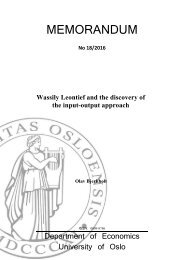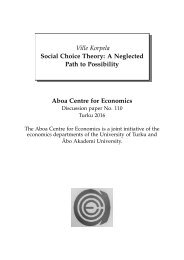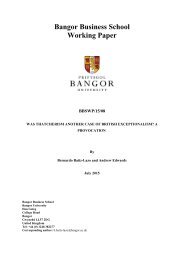Cheat Perish? A Theory Scientific Customs
n?u=RePEc:tut:cccrwp:2016-03-ccr&r=hpe
n?u=RePEc:tut:cccrwp:2016-03-ccr&r=hpe
You also want an ePaper? Increase the reach of your titles
YUMPU automatically turns print PDFs into web optimized ePapers that Google loves.
Filename: scientificmisbehavior-proofreading-dbspaceAC2.pdf December 1, 2016<br />
now be rewritten as:<br />
[<br />
]<br />
0 = u L (yt L ) − ((1 − π)y H min − yL t ) × u L′ (yt L ) −<br />
T<br />
∑<br />
k=t+1<br />
1 (<br />
(1 − π)y<br />
H<br />
δ k−t min − y L ) k<br />
k ∏<br />
m=t+1<br />
µu L (y L m)<br />
(1 − π)u H u L′ (yt L ), t = 1...T. (17)<br />
min<br />
The first term is equivalent to the first-order condition for the short-run equilibrium (equation<br />
(11)). The second term represents the impact of y L on the principal’s costs in future periods<br />
(the contagion effects). The first-best optimal salary is higher than the short-run optimal salary<br />
in all periods except for the last, as it brings about lower future costs. If the parameters of the<br />
model do not change, the optimal salary falls over time and, in the last period, the optimal<br />
salary is set at its short-run optimal level.<br />
Second-best optimal contract. A policy under which income falls over time (at least up to<br />
the last period, as in the first-best optimal contract) may not be socially acceptable. We now<br />
consider that the principal is not totally free to set the optimal income in each period, and thus<br />
has to design a second-best optimal policy. We suppose that the non-myopic principal knows<br />
that remuneration affects the future size of the population of cheaters. However, the principal<br />
is restricted in designing the policy, since income cannot change over time. The optimization<br />
problem is<br />
min<br />
{y L }<br />
PEC = ∑ T t=1<br />
ec t (y L ,β t (y L ,β t−1 ))<br />
δ t−1<br />
where β t (y L ,β t−1 ) = 1 − v(β t−1)u L (y L )<br />
, t = 1...T.<br />
(1−π)u H min<br />
(18)<br />
The first-order condition is:<br />
dPEC<br />
dy L =<br />
T<br />
∑<br />
t=1<br />
which can be rewritten as:<br />
0 =<br />
T<br />
∑<br />
t=1<br />
T −1<br />
∑<br />
t=1<br />
(<br />
1 ∂ect<br />
δ t−1 ∂y L + ∂ec )<br />
t ∂β t<br />
∂β t ∂y L<br />
+<br />
T<br />
∑<br />
t=2<br />
t−1<br />
1 ∂ec t ∂β<br />
δ t−1 ∂β t<br />
∑<br />
k<br />
k=1<br />
t−1<br />
∂y ∏ L<br />
m=k<br />
1<br />
[<br />
]<br />
δ t−1 v(β t−1) u L (y L ) − ((1 − π)y H min − yL ) × u L′ (y L ) −<br />
[ µu L (y L )<br />
1<br />
δ t<br />
t<br />
∑<br />
k=1<br />
(1 − π)u H min<br />
∂β m+1<br />
∂β m<br />
= 0, (19)<br />
] k ]<br />
v(β t−k )[<br />
((1 − π)y H min − yL ) × u L′ (y L ) . (20)<br />
As in the first-best case, the second-best optimal salary is higher than the short-run optimal<br />
salary as the principal takes into account that a higher low-type salary reduces the future<br />
population of cheaters, and so future costs. However, remuneration does not change over<br />
time, implying higher costs for the principal.<br />
Let yt<br />
First and yt<br />
Second denote the optimal incomes of low-type researchers in the first- and<br />
second-best contracts respectively. As can be seen from equations (17) and (20), marginal<br />
16





